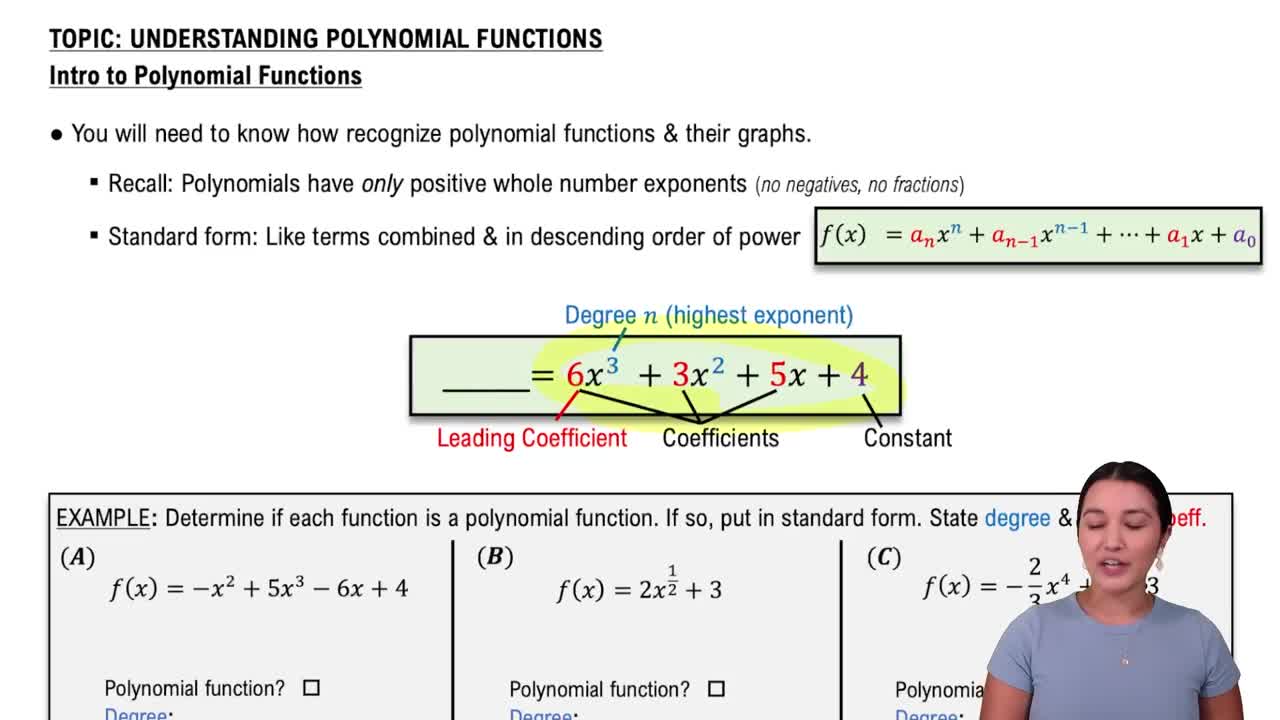Table of contents
- 0. Review of Algebra4h 16m
- 1. Equations & Inequalities3h 18m
- 2. Graphs of Equations43m
- 3. Functions2h 17m
- 4. Polynomial Functions1h 44m
- 5. Rational Functions1h 23m
- 6. Exponential & Logarithmic Functions2h 28m
- 7. Systems of Equations & Matrices4h 6m
- 8. Conic Sections2h 23m
- 9. Sequences, Series, & Induction1h 19m
- 10. Combinatorics & Probability1h 45m
4. Polynomial Functions
Dividing Polynomials
Problem 51
Textbook Question
Use synthetic division to determine whether the given number k is a zero of the polyno-mial function. If it is not, give the value of ƒ(k). ƒ(x) = 2x^3 - 6x^2 -9x + 4; k=1
 Verified step by step guidance
Verified step by step guidance1
Write down the coefficients of the polynomial: 2, -6, -9, 4.
Set up the synthetic division by writing k = 1 to the left and the coefficients to the right.
Bring down the leading coefficient (2) to the bottom row.
Multiply k (1) by the number just written on the bottom row (2) and write the result under the next coefficient (-6).
Add the numbers in the second column (-6 and 2) and write the result in the bottom row. Repeat the multiply and add process for the remaining coefficients.
 Verified video answer for a similar problem:
Verified video answer for a similar problem:This video solution was recommended by our tutors as helpful for the problem above
Video duration:
7mPlay a video:
Was this helpful?
Key Concepts
Here are the essential concepts you must grasp in order to answer the question correctly.
Synthetic Division
Synthetic division is a simplified method of dividing a polynomial by a linear binomial of the form (x - k). It allows for quick calculations by using the coefficients of the polynomial and the value of k. This technique is particularly useful for determining if k is a root of the polynomial, as it provides the remainder directly, which indicates whether the polynomial evaluates to zero at that point.
Recommended video:

Higher Powers of i
Polynomial Functions
A polynomial function is a mathematical expression involving a sum of powers in one or more variables multiplied by coefficients. The general form is ƒ(x) = a_nx^n + a_(n-1)x^(n-1) + ... + a_1x + a_0, where n is a non-negative integer and a_n is not zero. Understanding the structure of polynomial functions is essential for analyzing their behavior, including finding zeros and evaluating the function at specific points.
Recommended video:

Introduction to Polynomial Functions
Evaluating a Function
Evaluating a function involves substituting a specific value for the variable in the function's expression to find the corresponding output. For example, to evaluate ƒ(k) for a given k, you replace x in the polynomial with k and compute the result. This process is crucial for determining whether k is a zero of the polynomial, as a zero means the function evaluates to zero at that point.
Recommended video:

Evaluating Composed Functions
Related Practice
